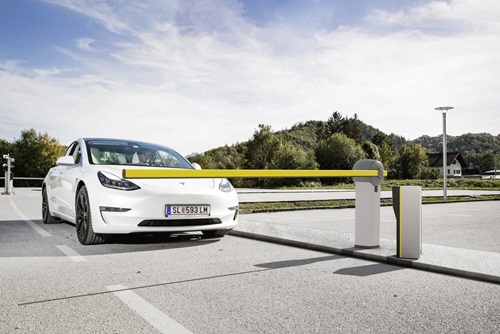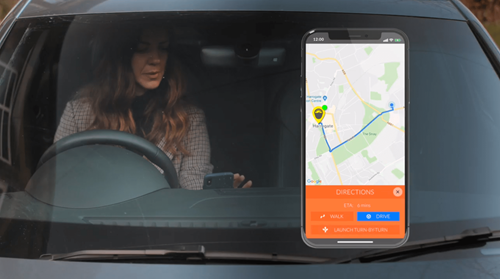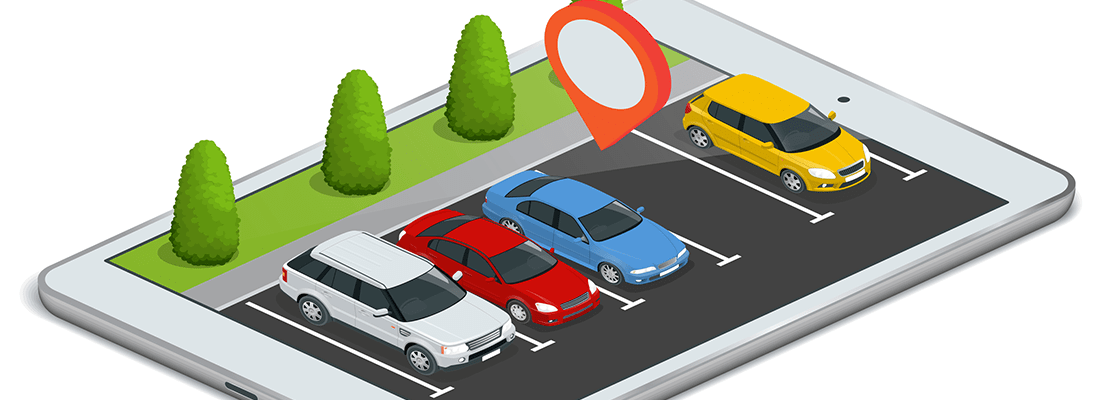Here to stay? Identifying trends in the parking sector
Identifying trends in the parking sector… how Covid-inspired innovations have forced their way into permanent thinking
With Europe seemingly hurtling back into various stages of lockdown amid the second wave of Covid-19, will we see another slew of local and national authorities using this period of increased uncertainty to introduce novel and innovative transport schemes as we did in the spring? The parking sector was particularly proactive in reducing fees and speeding the transition to touch-free transactions, but has this meant that there are new and unexpected trends to follow? Are cities more open to innovation than they were this time last year? And, ultimately, how will drivers benefit from this new way of thinking?
Many of us are in the fortunate position of driving an intelligent car. We drive that intelligent car on an intelligent road into a smart city. And then we leave it on a piece of open land divided into spaces with white lines. Or we might leave it on the street or in a multi-level parking structure. And the chances are we are going to have to pay for that privilege, and if you are parking in a major city it could easily cost you €20-30 for a few hours. Smart car, smart road, smart city…
This is, perhaps, the perception of the drivers who spend countless hours each year trawling around towns and cities looking for somewhere to park but it isn’t the reality. One only has to look at the number of OEMs and vendors that fill the Parking hall at Intertraffic Amsterdam to know that smart parking has been in existence for as long as smart cars (as opposed to the SmartCar) and the level of innovation in the sector is on a par with any other in the intelligent transport and smart city sphere. So what are we seeing in terms of trends? And what are we likely to see by way of a response to the ever-changing landscape of Coronavirus World? How many of the temporary measures and schemes that were brought in earlier in the year are likely to remain in place? And what role does parking have to play in our new reality?
Active not reactive
According to Julian O’Kelly, Head of Technology Innovation and Research at the British Parking Association (BPA) and participating in one of our previous webinars, the call for cleaner air, net zero living and a fully digital mobility landscape was gaining momentum pre-pandemic, pushed along by behavioural, political and technological forces.
“Concerns regarding public transport, reduced traffic and attempts to improve wellbeing during the pandemic have accelerated the need for sustainable action in transport and mobility. It’s clear that the release of social distancing measures over an extended period of time can help nations capture emerging benefits, such as carbon reduction and health outcomes. However, these benefits are unlikely to remain without clear strategic connections, as well as investment across different sectors, technologies, and policies.”
The BPA has been at the forefront of ensuring the parking sector takes a proactive and strategic role as the situation evolves and it’s also actively lobbying government and bringing together its membership community in a diverse range of areas in an effort to support lasting positive change.
“Active travel offers a socially distanced and healthy way to get around, and the UK government has signalled its desire to boost development through its ‘Gear Change’ initiative, with a £2 billion (€2.2 billion) active travel fund and emergency funding for cycle lanes and pedestrianisation measures during the pandemic,” explains O’Kelly. “However, many of us will continue to rely on our cars for safe travel over long distances, so effective parking management has a vital role to play in enabling active travel, particularly for last mile journeys. The BPA has acknowledged this with ‘Park Active’, an initiative developed in partnership with government and other active travel stakeholders. Park Active provides parking operators with a branded, practical framework to enable car parks to offer onward cycling and walking options to city centres, tourist attractions, or large employers such as hospitals.”
Parking for healthcare staff and frontline key workers was recognised as a priority so during lockdown the BPA partnered with app provider members to create an online map of all free parking offers for these groups.
“We’re continuing to work with government to establish how free or prioritised parking can work for them going forward, particularly with the strategic needs of these groups during the ‘second’ wave of the virus,” says O’Kelly.
27 October: Join our next webinar with Cerema, Flowbird and PARK NOW
Be part of our next webinar on October 27: Parking as an inteagral part of the seamless travelling experience with Peggy Mertiny of CEREMA, Thierry Brusseaux of Flowbird and Esther van der Meer of PARK NOW. Register now
Touchpoint
One emerging trend that has gained traction over the last few months has been the move towards touchless or “Corona-proof” parking. Until the pandemic struck in the spring it didn’t seem a particularly dangerous thing to press buttons on a parking ticket machine, open a shop door by the handle, fish around in your purse or pocket for 20-year old pieces of metal that have been touched by thousands of complete strangers, open the door again and plunge those same fingers into a bag of crisps, transferring the food and a significant number of germs into your mouth. After seven months of hand-sanitising and touching buttons with your sleeve our previous habits now seem alarmingly reckless. Almost by chance the touch-free parking market has come into focus with a ready-made solution.
For SKIDATA’s Vice President of Marketing, Florian Schneeberger, Covid-19 has driven his company to think outside was already quite a substantial box. “The touching of buttons when entering a parking structure or queuing at payment machines is inconvenient for customers. For operators increased disinfection measures are both indispensable and time-consuming, thus, we have developed our Touchless Solutions that can be instantly integrated into existing systems. Booking online at home, presenting only the hand at the entrance column instead of pushing a button, the license plate recognition or the payment solution by credit card on a pay-later-base are only some examples for our thought-out and integrated system from a single source.”

"Perfect parking management begins at the customer’s home.”
For Schneeberger it’s all about thinking ahead and the customer experience, which, in these uncertain times, is more important than ever. “All these developments ensure the best possible experience for parking customers which makes them come again – as I see it, perfect parking management begins at the customer’s home.”
The trend identified by SKIDATA is to include parking as an integral part of Mobility as Service (MaaS) solutions.“Smart mobility like public transport and the offer of MaaS is the name of the game in cities,” insists Schneeberger. A partnership between providers of different services will create a comprehensive and convenient customer journey. Another very important point is the possibility to book an EV-charge slot online and to ensure the customer’s electric vehicle is charged and ready to go at the end of the stay. I can sum this up very simply,” he concludes. “Operators who upgrade their premises now will be the ones who succeed in future.”
It’s clear how Covid-19 has affected the current state of the parking sector, but how is it likely to impact on its future? Companies such as Miami-based licence-plate recognition (LPR) specialists Survision have invested heavily (in both time and finance) in future-proofing their technology and, as VP of Sales Alexandra Maillot explains, they’ve had to re-think and re-shape their vision of what the parking sector will look like over the next decade.
“The only way to do right by parking operators was to adapt. Luckily the parking revenue control system suppliers known as PARCS were reactive enough to propose the solutions that were already developed but didn’t previously have the chance to shine. Users of parking spaces are often resistant to change but this time we've all been happy to use any alternatives to avoid touchpoints such as ticket machines."
"The industry has probably skipped ahead 10 years in terms of latest technology adoption in the last few months."
“The parking industry started to use modern, easy, touchless, frictionless, pre-paid, free-flow technologies to park. We see more ‘wave your hand’, Bluetooth, licence plate recognition, pay-by-phone, and many other technologies to easily park. The industry has probably skipped ahead 10 years in terms of latest technology adoption in the last few months.”
LPR is by no means a new technology but as Alexandra points out it is the only solution that allows drivers to enter and exit a car park without estopping.“Like every technology, LPR is not 100% accurate and our licence plate is not always visible. I’m thinking about potential obstructions such as bike racks that will obscure the licence plate for example. So there is a backup solution that is needed for around 10% of parking users, but there are still 90% who will have the best parking experience without touching anything and not even opening the window of their car.”
There are, of course, far more benefits to using LPR than just safe, touchless access to a parking structure. It’s an excellent solution to bring a better experience to parking users through frictionless access too.
“LPR helps parking operations better understand and adapt to parking users’ habits. And it also brings security to any parking facility, and brings the feature ‘find my car’ into the equation and many other benefits we all will be happy to have once we are back to normal,” she says. “Let’s make it a new modern normal.”
No stress
Another company that is at the forefront of touch-free solutions is South London’s Hozah, founded by serial entrepreneur David Fowle in 2016. Hozah’s innovative ‘touch-free, hassle-free’ parking system could not be simpler to use. It’s not even an app, so drivers who don’t own a smartphone aren’t excluded. All that is needed is access to the Internet and a payment card. Visit the website, enter your name, the car registration details and a payment card number and drivers don't have to do anything else until they change their car or the card expires. Drive into a Hozah-enabled car park, go shopping or visit a relative in hospital, return to the car, drive away and be automatically charged for the length of stay thanks to the ANPR system.
A solution such as Hozah’s is particularly relevant for the hospital scenario as typically the last half-hour of visiting time is spent checking your phone or watch to ensure you don’t go over your allotted parking time. Says Fowle: “The transference of a visitor’s stress can have unhealthy and negative impacts on the patient they have come to see. With our solution the entire visit can be enjoyed fully and the patient isn’t picking up on their visitor’s anxiety to be back at their car in time.”
Listen to Inside Intertraffic podcast series
Want to hear more from David Fowle? Listen to this edition of Inside Intertraffic's podcast.
Another bonus of implementing a touchless, clickless system is that higher penetration of enabled car parks equates to higher compliance to parking regulations and thus longer lengths of stay and, crucially, higher revenue generation for the local economy in the post-Covid world.
Paul Bowman, Coventry City Council’s parking services manager says: “Hozah allows drivers the opportunity to experience fully automatic, frictionless parking and is another step towards making Coventry City a truly connected Smart City. It is of paramount importance that truly touchless systems are readily available following coronavirus. With Hozah drivers are offered the safest possible way to pay while at the same time, leading to higher revenue generation for Coventry’s local economy.
Touchless parking has numerous benefits. No stress. No hassle. No contact. No penalty charge notice. No time limit. No app. No cash. No awkward phone call from a wet and windy car park. An increase in local business revenue and a much-needed and timely boost to the economy.
“The conversation has changed over the past few months,” says Naomi Bishop, co-founder and operations director of Hozah. “When we’re talking to councils and local authorities now the wording has changed subtly from discussing implementing one of our systems ‘with’ someone else’s or something else, to a Hozah-only solution. They can see that we’re in the business of generating revenue for them.
A twin-win situation
So, it would seem, all of the new parking trends and innovations identified so far have either been fashioned, heightened or propelled by the coronavirus. That it’s taken a global pandemic for local and national authorities to become more receptive to new ideas is perhaps material for another article but let’s just focus on the eyes that have already been opened and, like AppyWay’s Head of Mobility, Kerbside and Parking Solutions, Ben Boutcher-West, accentuate the positive.
“During the pandemic we have seen a range of changes to our road network, the increase of temporary cycle lanes, linking the capital and other urban centres in new cycle highways, the suspension of parking payments in many towns to support free movement during the crisis and encourage people to city centres using cars to reduce human contact. We have even recognised a more relaxed approach to enforcement generally while delivery vans and logistics traffic kept pace with the greatest home delivery demand the UK has seen."
“The challenge that each of these changes share has been the creation, implementation and maintenance of the new services, and their impact on existing regulation orders. We applaud many of the changes to maintain safe access choices for as many people as possible during the pandemic but have noted that the creation, for new cycle lanes as one example, has been especially problematic.”

“To manage all these changes, reduce costs and remain an active controller of services at the kerbside, all local authorities are going to need digital twins of their regulation orders, in accurate maps, that can be easily shared and exchanged."
Boutcher-West explains that many moving traffic orders (MTOs) and traffic regulation orders (TROs) remain text-based, making the process of review and amendments time-consuming and costly to local authorities to implement. Once implemented, the task of maintaining a digital ledger of their location, health, and eventual maturity is labour-intensive. Legacy systems that do digitise regulation enjoy little integration across different government departments.
“The Covid-19 related changes happened quickly and saw a great impact on our urban design. Impact on the very same streets that over the next 10 years are going to undergo constant evolution as EV uptake increases and we see further penetration of services such as car clubs, and shared and active transport modes at scale,” he says. “To manage all these changes, reduce costs and remain an active controller of services at the kerbside, all local authorities are going to need digital twins of their regulation orders, in accurate maps, that can be easily shared and exchanged across varying departments within the transport sector, and have them reviewed in real time. This digitisation is also essential for the public to consult upon many of these complex and often political kerbside changes.”
As for an identifiable trend, Boutcher-West is keen that at least some of the temporary measures brought in earlier in the year are made permanent. “From all the change the pandemic has brought, I’d like to see a spotlight is shone on the need for further uptake of digital TROs and MTOs as a standard, along with funding, within our local authorities to implement these services. We have seen that the demand for digital TROs has been expedited and in addition we are also enjoying the increased demand for further integration with our partners, like Elgin, to deliver the full potential of digital regulation orders for local authorities.”
A further benefit of digitisation within the local authority, says Boutcher-West, is the ability to exchange data accurately and in real time to “those who need it most, those who enjoy access in our cities to benefit from employment, education and healthcare for example, through APIs and SDKs. All of this is only possible through a digitised kerbside and digitised regulations.”
If our experts are correct then the future of parking is going to be touchless, cleaner, greener, licence-plate based and digitised, fuelled by behaviour, compliance, policy and technology. At the end of the day we’ll still be parking our cars between painted white lines but in real terms that’s where the old normal ends.
Do you have an innovation, research results or an other interesting topic you would like to share with the professionals in the infrastructure, traffic management, safety, smart mobility and parking industry? The Intertraffic website and social media channels are a great platform to showcase your stories!
Please contact our Sr Brand Marketing Manager Carola Jansen-Young.
Are you an Intertraffic exhibitor?
Make sure you add your latest press releases to your Company Profile in the Exhibitor Portal for free exposure.





